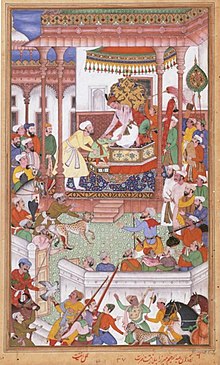Abdul Rahim Khan-e-Khanan
Abdur-Rahim Khan-e-Khanan (born around 1557 ; died 1627 ) was an important general and poet in the Mughal Empire .
Abdur-Rahim was the son of the general Bairam Khan and the daughter of a Mewati prince . When his father was removed from office and murdered on January 31, 1561 on a trip to Mecca , his mother fled with him from the court. However, the young mogul Akbar I had Abdur Rahim brought back, encouraged him and entrusted him with important offices.
Abdur-Rahim successfully participated in the conquest of Gujarat , Sinds and the battles for the northern Deccan . He held the post of khankhanan (generalissimo, Persian خان خانان, DMG khān-i khānān , literally "Khan of the Khans"). In September 1583 he completed the submission of Gujarat. To celebrate this victory, he had the city of Ahmadabad adorned with a victory park , the Fathbag . During a campaign in the Deccan, on which Akbar's son Murad accompanied him, he had a library built in the city of Burhanpur , the remains of which still exist today. In November 1600, he took the Asirgarh fortress, which was allegedly defended by 34,000 people . Bribery or treason is suspected when it was surrendered.
In the following period he fell out of favor under Jahangir at times. Re-appointed commander in the Deccan, he and his son Iraj Shahnawaz led battles against the military leader Malik Ambar . Because of his support for Shah Jahan , the disgraced son of Jahangir, he was again dismissed, but recalled to court in 1627. He died that same year.
Abdur-Rahim was also active as a poet in the languages Persian , Chagataisch and Hindi . He sponsored more than a hundred poets and is considered one of their greatest patrons during the Mughal period. He himself wrote less in Persian than in Hindi, under the poet's name Rahīm . His Hindi poems are still popular today. Unfortunately, there aren't many manuscripts of his Hindi poems that have been passed on orally. Hence some of his dohas are ascribed to other poets. His best-known Hindi work is Nagar-shobhā ("The City of Beauty "), in which he praises the erotic virtues of women from various professions, from Brahmaness to washerwoman. He thus places himself both in the Hindi tradition of the "heroine poem " ( nayikābheda ) and in the Persian tradition of the Schahrāschōb literature, in which various beautiful men are extolled. He also translated the autobiography of the Mughal Mughal Babur ("Bāburnāma") from Chagata into Persian. Among other things, the poet Ḥusain Ṯanāʾī Mašhadī was in his service.
What is very unusual for a Mughal general is that there is a contemporary biography of Abdur-Rahim. The poet Nihāvandī wrote this biography in Persian in 1616 under the title Ma'āsir-i Raḥīmī ("The Rahim's exploits").
literature
- Annemarie Schimmel : In the realm of the Mughals: history, art, culture. CH Beck, Munich 2000, ISBN 3-406-46486-6
- TCA Raghavan: Attendant Lords: Bairam Khan and Abdur Rahim, Courtiers and Poets in Mughal India , Noida UP: Harper Collins India, 2017, ISBN 93-5264-301-1 .
- Shāh Navāz Khān, Navvāb Ṣamṣām ud-Daula, and 'Abd ul-Ḥayy: The Maāthir-ul-Umarā , being biographies of the Muhammadan and Hindu officers of the Timurid Sovereigns of India from 1500 to about 1780 AD, translated into English by Henry Beveridge, revised, annotated and completed by Baini Parshad, 2 vols. And Index, Kolkata: Asiatic Society 1952, rep. 2003, ISBN 81-7236-145-9 .
- Nihāvandī, 'Abdulbāqī: Maās̱ir i Raḥīmī , memoirs of ʿAbd ul-Raḥīm Ḵẖān Ḵẖānān, Persian text edited by Shams-ul-ʿUlamāʼ M. Hidāyet Husain, Kolkata: Asiatic Society of Bengal, 1925.
Web links
Individual evidence
- ↑ Sunil Sharma: Mughal Arcadia, Persian Literature in An Indian Court , Cambridge and London: Harvard University Press, 2017, p. 48 f.
- ↑ Ibid. P. 100 f.
- ↑ Elke Niewöhner: An astronomical-astrological poem by the Persian poet Ḥusain Ḥakīm Ṯanāʾī Mašhadī on the Berlin Indian world map, in: Der Islam , (2019), vol. 96, no. 1, pp. 121–157, p. 127
- ↑ Sharma p. 100.
| personal data | |
|---|---|
| SURNAME | Abdul Rahim Khan-e-Khanan |
| ALTERNATIVE NAMES | Abdur Rahim |
| BRIEF DESCRIPTION | General in the Mughal Empire and poet |
| DATE OF BIRTH | around 1557 |
| DATE OF DEATH | 1627 |
